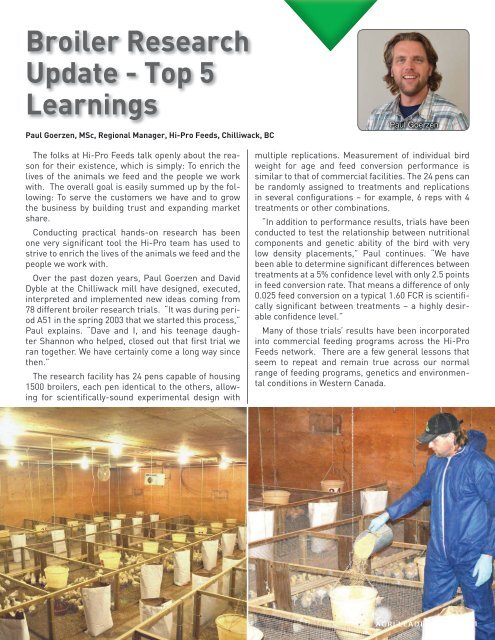You also want an ePaper? Increase the reach of your titles
YUMPU automatically turns print PDFs into web optimized ePapers that Google loves.
Broiler Research<br />
Update - Top 5<br />
Learnings<br />
Paul Goerzen, MSc, Regional Manager, Hi-Pro Feeds, Chilliwack, BC<br />
Paul Goerzen<br />
The folks at Hi-Pro Feeds talk openly about the reason<br />
for their existence, which is simply: To enrich the<br />
lives of the animals we feed and the people we work<br />
with. The overall goal is easily summed up by the following:<br />
To serve the customers we have and to grow<br />
the business by building trust and expanding market<br />
share.<br />
Conducting practical hands-on research has been<br />
one very significant tool the Hi-Pro team has used to<br />
strive to enrich the lives of the animals we feed and the<br />
people we work with.<br />
Over the past dozen years, Paul Goerzen and David<br />
Dyble at the Chilliwack mill have designed, executed,<br />
interpreted and implemented new ideas coming from<br />
78 different broiler research trials. “It was during period<br />
A51 in the spring 2003 that we started this process,”<br />
Paul explains. “Dave and I, and his teenage daughter<br />
Shannon who helped, closed out that first trial we<br />
ran together. We have certainly come a long way since<br />
then.”<br />
The research facility has 24 pens capable of housing<br />
1500 broilers, each pen identical to the others, allowing<br />
for scientifically-sound experimental design with<br />
multiple replications. Measurement of individual bird<br />
weight for age and feed conversion performance is<br />
similar to that of commercial facilities. The 24 pens can<br />
be randomly assigned to treatments and replications<br />
in several configurations – for example, 6 reps with 4<br />
treatments or other combinations.<br />
“In addition to performance results, trials have been<br />
conducted to test the relationship between nutritional<br />
components and genetic ability of the bird with very<br />
low density placements,” Paul continues. “We have<br />
been able to determine significant differences between<br />
treatments at a 5% confidence level with only 2.5 points<br />
in feed conversion rate. That means a difference of only<br />
0.025 feed conversion on a typical 1.60 FCR is scientifically<br />
significant between treatments – a highly desirable<br />
confidence level.”<br />
Many of those trials’ results have been incorporated<br />
into commercial feeding programs across the Hi-Pro<br />
Feeds network. There are a few general lessons that<br />
seem to repeat and remain true across our normal<br />
range of feeding programs, genetics and environmental<br />
conditions in Western Canada.<br />
AGRI LEADER » 2016<br />
71


